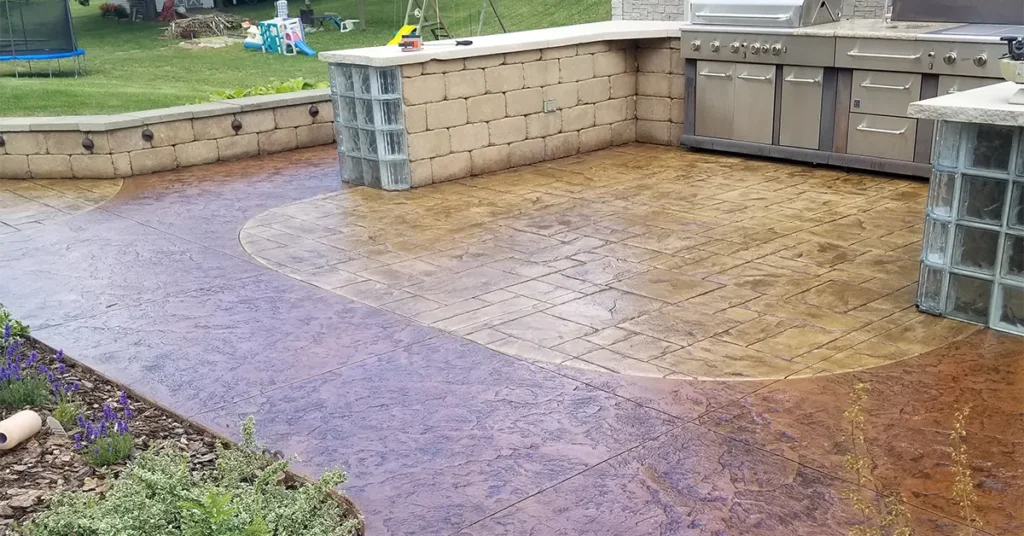Think concrete floors are just for warehouses and garages? Think again. Stained concrete floors are taking homes by storm, and for good reason. They’re tough as nails, look amazing, and won’t break your budget or your back with endless maintenance.
Whether you’re building a new home or ready to ditch that old carpet, stained concrete floors might be exactly what you need. Let’s dive into everything you need to know about this game-changing flooring option.
The Secret Behind Stained Concrete’s Stunning Appeal
Stained concrete floors start with a regular concrete slab, but ordinary ends there. The magic happens when special stains soak deep into the concrete, creating rich colors and unique patterns that can’t be scratched or peeled off.
Unlike paint or coatings that sit on top, stains actually bond with the concrete itself. This means your floor’s color becomes part of the concrete, not just something covering it up. The result is a floor that gets better with age instead of looking worn out.
You’ll find two main types of concrete stains:
Acid-based stains work like a science experiment. They react with minerals in the concrete to create natural-looking colors that vary across the floor. No two spots look exactly the same, giving you that one-of-a-kind, organic appearance.
Water-based stains give you more control over color. They don’t rely on chemical reactions, so you get consistent colors and can choose from a wider range of shades, including bright blues and greens that acid stains can’t produce.
Notable Benefits That Make Homeowners Fall in Love
They’re Practically Indestructible
Concrete floors laugh in the face of daily wear and tear. Drop something heavy? No problem. Spill red wine? It happens. Kids running around with muddy shoes? Bring it on.
These floors handle whatever life throws at them. They won’t dent like hardwood, tear like carpet, or crack like tile. For busy families, this durability means one less thing to worry about.
Maintenance is a Breeze
Remember spending weekends shampooing carpets or refinishing hardwood? Those days are over with stained concrete floors. A quick sweep and occasional mopping are all they need to look fantastic.
The sealed surface resists stains and spills. Most messes wipe up easily, and you don’t need special cleaners or equipment. Just your regular mop and some warm water do the trick.
Your Budget Will Smile Back at You
Stained concrete floors offer excellent value compared to hardwood, natural stone, or high-end tile. The initial investment is significantly lower than many premium flooring options, making them accessible for most budgets.
The money you save upfront stays in your pocket long-term, too. No carpet cleaning bills, no hardwood refinishing costs, and no replacing worn-out flooring every few years.
Endless Design Possibilities
Stained concrete floors aren’t stuck with that industrial gray look. You can choose from earthy browns and warm tans to cool blues and sophisticated charcoals. Want something bold? Try deep reds or forest greens.
The staining process can create different effects, too. Some people love the natural variation of acid stains, while others prefer the uniform color of water-based stains. You can even combine colors or add decorative elements like scoring or stamping.
Room by Room: Where Residential Stained Concrete Shines Brightest
Don’t limit yourself to thinking that stained concrete floors only work in basements or garages. These floors are popular choices for residential spaces throughout the home.
Living Areas: Stenciled concrete floors that flow seamlessly from room to room create an open, spacious feeling. They’re perfect for homes with open floor plans.
Kitchens: Properly sealed concrete prevents spills and stains. Plus, the smooth surface makes cleaning up cooking messes quick and easy.
Bathrooms: Unlike wood or carpet, concrete doesn’t mind getting wet. Sealed stained concrete floors in bathrooms are both practical and stylish.
Bedrooms: Worried about cold floors? Concrete holds temperature well and works great with radiant heating systems for cozy winter mornings.
Behind the Scenes: Your Floor’s Amazing Transformation Journey
Getting stained concrete floors isn’t complicated, but it does require some planning. Here’s what typically happens:
Preparation: Your existing concrete gets cleaned and prepped. Any cracks get repaired, and the surface is ground smooth if needed.
Staining: The chosen stain is applied according to the manufacturer’s instructions. Acid stains might need neutralizing afterward, while water-based stains usually don’t.
Sealing: Once the stain is set, a protective sealer is applied. This step is crucial for protecting your investment and making maintenance easy.
The whole process usually takes a few days to complete, depending on the size of your home and the complexity of your design.
Keep Your Floors Looking Fresh (It’s Easier Than You Think)
One of the biggest advantages of stained concrete floors is their ability to maintain. Here’s your simple care routine:
Daily: Sweep or vacuum to remove dirt and debris. That’s it for most days.
Weekly: Mop with warm water and a pH-neutral cleaner. Avoid harsh chemicals that might damage the sealer.
Monthly: Check for any areas that might need attention. Look for worn spots in high-traffic areas.
Yearly: Consider having the sealer checked by a professional. Depending on traffic and wear, you might need resealing every few years.
FAQs
How long do stained concrete floors last?
Stained concrete floors can last 20-30 years or more with proper installation and basic care. The stain penetrates deep into the concrete, so it won’t wear off like paint or surface coatings. Most homeowners find their floors still look great after decades of use.
Can you install stained concrete floors over existing concrete?
Yes, in most cases. If your existing concrete slab is in good condition, you can stain it. However, some prep work might be needed first if you have painted concrete, severe cracks, or oil stains. A professional can assess your specific situation and recommend the best approach.
Are stained concrete floors slippery when wet?
Properly sealed stained concrete floors, similar to tile or hardwood, can be slippery when wet. However, you can choose textured sealers or add slip-resistant additives to improve traction. This is especially important for bathrooms, kitchens, or entryways where water might be present.
How much does it cost to stain existing concrete floors?
Staining existing concrete slabs is generally more budget-friendly than installing new flooring from scratch. The total investment depends on the complexity of your design, the condition of your existing concrete, and your location. Extensive prep work is needed to repair cracks or remove old coatings, so expect higher costs..
Can pets damage stained concrete floors?
Stained concrete floors are very pet-friendly. Dog claws won’t scratch them, and accidents clean up easily from the sealed surface. Unlike carpet or hardwood, you don’t have to worry about permanent stains or odors. Many pet owners love how easy these floors make cleanup after muddy paws or spills.
Do stained concrete floors add value to your home?
Yes, stained concrete floors often increase home value because they’re seen as a modern, low-maintenance upgrade. They appeal to buyers who want stylish flooring without the ongoing costs of carpet replacement or hardwood refinishing. The exact value increase depends on your local market and overall home condition.
Conclusion
Stained concrete floors offer an unbeatable combination of style, durability, and value. Whether you’re going for a modern farmhouse look or contemporary residential design, these floors can work beautifully in your home.
As a smart long-term investment, stained concrete floors pay dividends for years to come. They’re tough enough for active families, stylish enough for entertaining, and low-maintenance enough to give you back your weekends.


